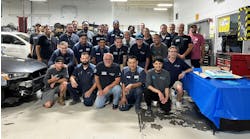How are you preparing your shop for the real world?
Leaving all of this to chance is very dangerous with a huge potential impact. Inattention to the view you present to the buying public can have a tremendous impact on how you and your business are perceived and can be devastating to the viability of the business you have worked so hard to establish. There is little doubt that if you strive from the day you open your door to be the cheapest guy in town, you quite naturally will gain a certain reputation and customer perceptions toward low prices.
But if in the midst of this you suffer regular customer complaints or have poor relations with your customers, you are just as likely to gain a reputation and grow customer perceptions in directions far from what you had planned and a long way from what you would have your business represent. It is very important to take an active role in what you are representing to your customers and the buying public and take an active part in painting that picture.
Painting the Right Picture
An important first step in all of this is our deciding and getting comfortable with who we are as a company or organization and how we will present that to our customers and end users. It is not enough to just leave all of this to chance and not acceptable to do nothing. We need to be true to who we are while at the same time work to find a way to connect and be relevant in the markets we occupy or hope to occupy.
With search engines and online surveys, search engine optimization (SEO), electronic yellow pages and all forms of social media, the ways that we go about presenting ourselves to consumers have changed dramatically over the past decade. Even in small towns, how people shop and how we make ourselves visible to the buying public is an incredibly complex and incredibly critical challenge that all of us face every day. It is entirely conceivable that some customer interaction we had this morning (good or bad) could end up posted in graphic detail on the Internet this afternoon.
Though certain aspects of this are entirely out of our control, it is extraordinarily important that we have a plan and a process here and not leave these public perceptions to chance. The majority of us go online and check up on who is out there before they ever hop in their car and venture out to make a purchase and being aware of what image we are presenting to the public is critical to our continuing to consistently attract and retain customers.
Walk the Walk
Now that we have discussed the importance of the message, we need to move toward crafting that message and in this process find a way to be true to our values while being relevant to our customers and potential customers. If price or the quality of our work is the thing that we choose to highlight, we need to find ways for these things to make it into our customer interactions, into our marketing, onto our website and into our corporate culture.
It is not enough that we talk the talk of catchwords and clever phrases. But if this is how we wish to represent ourselves to our customers and if this represents our corporate values, then we need to walk that walk. We can't just leave these things to chance.
Before you jump in with a desire to be known for your pricing or the quality of your work, I want you to think about the things that might allow you to stand out from the crowd and get your customers and would-be customers feeling good about their decision to bring their car to you. Things like charities that you support or activities that add to and enhance your position in the community.
An example of this would be a great former client of mine who sponsors a charity golf tournament that supports Children's Hospital of Charlotte, N.C. Each year these guys make a huge and very public effort to stage this event, and each year they are rewarded with many active participants from among their customers and many more who willingly donate and support the event in other ways.
Here is an opportunity for the ownership to support a very worthy cause while staying true to their values and giving back to the broad community. That they are the beneficiary of incredible good will in this effort is very much beside the point. But I promise you that there is value to a perception of goodness and generosity.
I also can assure you that those types of perceptions drive customers to our doors and have them feeling very good about the journey. There is no doubt that good will such as this would drive sales far better than cheap prices but on the other side of it, after the sale, customer satisfaction and loyalty are both very strong.
Most of us like to associate with people and businesses that have values that are similar to our own. I would underscore the importance of our being very open and public with efforts along these lines because our knowing and feeling good about these efforts is a huge advantage. But we also need to find ways to let our customers know. There is no value for them in the effort unless they actually know about it. At every opportunity we need to highlight and celebrate our good works and our place in the community.
Perception is Reality
One of the most effective efforts towards public perceptions I have ever seen was an offshoot of a strong corporate value placed on providing exceptional customer service and the strong belief that great service drove sales and long term success. This shop, a high-end European shop in Spokane Wash., treats every customer like a long-lost relative. With more than 35 years in business, the owners have cultivated an extraordinarily loyal following that saw them through the recent downturn in very fine fashion, setting sales records all along the way. These owners (it is a family affair) work very hard to satisfy every customer. If car count and retention are any measure of success, they have benefitted from delivering excellence again and again and loyal customers who are willing to sing their praises. Customer perception definitely is their reality.
A mistake I see a lot of shop owners make is their efforts toward crafting those public perceptions and the idea that it is set in stone and that we only worry about it as we are opening our doors. New owners seem to go to great lengths to establish themselves as honest or less expensive or expert, and over the years seem to avoid rocking that perceptions boat. I would make the point that our markets change, we change, customers' needs changes and as a direct result of that, we need to always be working to paint the right image. Always true to our values but relevant and pertinent to our customers and our place in the community.
The tire and automotive repair markets by their very nature are competitive with all of us vying for customers and market share as we try to hire and retain the best available technicians and service advisors. In the midst of this, we have to find ways to stand out from the crowd and be visible.
It's 8 o'clock. Do you know where your customer's perceptions are?
Brian Canning is 30-year veteran of the automotive repair industry who recently moved to the federal sector as a business analyst. For most of the past seven years he worked for a leading coaching company as a leadership and management coach and team leader. He started his career as a Goodyear service manager in suburban Washington, D.C., moving on to oversee several stores and later a region. He has been a retail sales manager for a distributor, run a large fleet operation and headed a large multi-state sales territory for an independent manufacturer of automotive parts.



